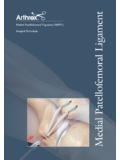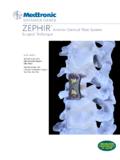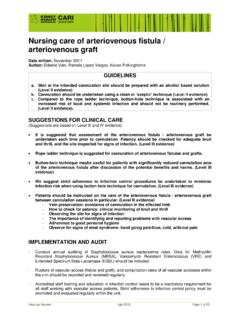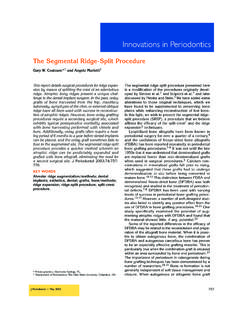Transcription of Perioperative Use of Antibiotics in Cutaneous Surgery
1 Objective Review the indications and use of prophylactic oral Antibiotics for Cutaneous surgical proceduresA Typical PatientObjectives The use of oral Antibiotics both prior to and after Cutaneous surgical procedures is controversialAntibiotics Adverse events that could arise following the use of a prophylactic antibiotic include: Dermatologic or systemic reaction to the medication Development of a resistant strain of bacteriaAntibiotics Use of prophylactic Antibiotics may be consideredwhen: A patient has a cardiac abnormality that increases his or her risk for infective endocarditisEndocarditis Prophylaxis Only 15% of cases of endocarditis are thought to be related to iatrogenic procedures Many cases of endocarditis arise in patients without a known cardiac defectHaas AF, Grekin RC 1995 Endocarditis Prophylaxis The risk of endocarditis following specific Cutaneous surgical procedures is unknown Guidelines for the prevention of infective endocarditis from the American Heart Association (JAMA 1997)
2 Do not specifically address the management of patients undergoing Cutaneous surgical proceduresDajani AS, Taubert KA, Wilson W et al 1997 Endocarditis Prophylaxis Studies have shown that oral Antibiotics as prophylaxis against infective endocarditis are often overusedin low risk patients and underusedin moderate risk patients Seto TB, Kwait D, et al, 2000 Endocarditis Prophylaxis During Cutaneous procedures, are dermatologic patients at risk for bacteremia that could result in endocarditis?Endocarditis Prophylaxis A cumulative incidence of bacteremia of has been reported in patients undergoing procedures such as excision, Mohs micrographic Surgery , and hair transplantationSabetta JB, Zitelli JA 1987; Halpern AC, Leyden JJ et al 1988; Zack L, Remlinger K et al 1989; Maurice PDL, Parker S et al 1991.
3 Carmichael AJ, Flanagan PG et al 1993 in George PM 1996 Endocarditis Prophylaxis Only 4 cases of endocarditis following Cutaneous surgical procedures (biopsy, excision, and cryotherapy) have been reported, making the development of endocarditis a very rare complication of Cutaneous surgeryGeorge PM 1996 Endocarditis Prophylaxis Information necessary for deciding the use of a prophylactic antibiotic to protect against endocarditis is the patient s underlying risk for the development of endocarditis? is the condition of the skin in the area to be treated? is the nature of the planned procedure?
4 Cardiac Risk Patients considered to be at moderate to high riskfor the development of endocarditis include those with:Dajani AS, Taubert KA, Wilson W et al 1997 Most congenital cardiac malformations Prosthetic heart valves Mitral valve prolapse with regurgitation Rheumatic and other forms of acquired valvular disease Hypertrophic cardiomyopathy Prior history of endocarditisCardiac Risk Patients with negligible riskinclude those with:Dajani AS, Taubert KA, Wilson W et al 1997 Previous coronary artery bypass graft Surgery Implanted pacemakers/defibrillators Mitral valve prolapse without regurgitation Physiologic or functional ( innocent )
5 Murmurs Ventricular septal defect or secundum atrial septal defect, or surgical repair of either defect Prior rheumatic heart disease or Kawasaki disease without valvular dysfunctionCardiac Risk In many cases, consultation with the patient s cardiologist may be helpful in determining the exact medical condition present and the specialist s recommendation regarding antibiotic prophylaxisSkin Condition The incidence of bacteremia during procedures on intact, noninfected skinis thought to be very low, especially with sterile preparation Antibiotic prophylaxis is not advised, even in high risk patientsSkin Condition Procedures on intact but heavily colonized areas of skin (groin, axilla, and foot)
6 Have an unknown risk of bacteremia Antibiotic prophylaxis may be considered in high-risk patientsSkin Condition The incidence of bacteremia during procedures on eroded but not infected skinis low, but eroded skin can be colonized with organisms that may cause endocarditis Antibiotic prophylaxis is indicated in high-risk patientsHaas AF, Grekin RC 1997 Skin Condition Procedures performed on clinically inflamed or infected skinhave an up to 35% incidence of bacteremia Antibiotic prophylaxis is strongly advised in high-risk patientsHaas AF, Grekin RC 1997 Planned Procedure If the epidermis and dermis are not significantly altered during the procedure, prophylaxis is not needed Examples include nonablative laser treatments and sclerotherapyPlanned Procedure If intactskin has been prepared in a sterile manner for a shave or punch biopsy, excision, curettage, or ablative laser procedure.
7 Antibiotic prophylaxis is not neededPlanned Procedure Mohs Surgery may be considered differently since it is a clean rather than a sterile procedure The extended period during which the wound is left open may increase the risk of bacteremia Antibiotic prophylaxis is recommended in high risk patientsMaragh SL, Otley CC et al 2005 Planned Procedure For procedures involving the oral or nasal mucosa, antibiotic prophylaxis is recommended for high-risk patientsJoint and Neurologic Prosthesis A recent review has suggested that patients with joint prostheses and neurologic shunts should be considered in the high risk category, and the use of preoperative Antibiotics should be consideredMaragh SL, Otley CC, et al 2005 Joint and Neurologic Prosthesis Another recent review advised that prosthetic joint infections due to bacteremia may be more likely in.
8 Patients who are immunocompromised or immunosuppressed Patients who have diabetes or are malnourished Patients whose joint replacement is less than 2 years oldMessingham MJ, Arpey CJ, 2005 Joint and Neurologic Prosthesis Consultation with the patient s orthopedist or neurologic surgeon can be helpful in determining the need for prophylactic preoperative antibioticsAntibiotic Selection Once the need for preoperative Antibiotics to prevent infection has been decided, the appropriate antibiotic must be chosenAntibiotic Selection Determined by the organism likely to be present at the treated sitePreoperative Antibiotics Ideally given orally as a single preoperative dose 1 hour before the start of the procedure A second dose may be given in procedures expected to last longer than several hours (Mohs Surgery )Antibiotic Selection.
9 Nonoral Sites Staphylococcus aureusand Streptococcus pyogenesare likely pathogensMaragh SL, Otley CC et al 2005 1st generation cephalosporin (cephalexin 2 g) Penicillinase-resistant penicillin (dicloxacillin 2 g) Clindamycin 600 mg Azithromycin 500 mg Clarithromycin 500 mgAntibiotic Selection: Oral and Nasal Mucosal Sites Streptococcus viridans, Peptostreptococcusspecies, S. aureus, Enterococcusspecies, and Escherichia coliare likely pathogens Amoxicillin 2 g is the antibiotic of choice for oral mucosal procedures Clindamycin 600 mg Cephalexin 2 g Azithromycin Clarithromycin 500 mgPrevention of Surgical Site Infection Use of prophylactic Antibiotics may be consideredwhen there is a risk of developing a postoperative wound infectionPrevention of Surgical Site Infection Wounds on intact, noninflamed skin made using sterile technique ( clean wounds)
10 Have a less than 5% chance of becoming infected, and postoperative Antibiotics are not recommendedMaragh SL, Otley CC et al 2005 and Messingham MJ, Arpey CJ 2005 Prevention of Surgical Site Infection Wounds of the oral or nasal mucosa, axilla, or groin, or wounds made with minor breaks in sterile technique ( clean-contaminated wounds) may benefit from postoperative Antibiotics since the risk of infection may be as high as 10%Maragh SL, Otley CC et al 2005 and Messingham MJ, Arpey CJ 2005 Prevention of Surgical Site Infection For wounds made in inflamed, traumatized, or devitalized tissue, or for wounds with major breaks in sterile technique ( contaminated or infected wounds)






